Effect of Different Fine Aggregate Characteristics on Fracture Toughness and Microstructure of Sand Concrete
Abstract
:1. Introduction
2. Experimental Programs
2.1. Experimental Materials
2.1.1. Fine Aggregate
2.1.2. Cement
2.1.3. Admixtures
2.2. Mix Proportion and Specimen Preparation
2.3. Test Methods
2.3.1. Physical Properties Test of Fine Aggregates
2.3.2. XRD Test
2.3.3. Compressive Strength and Flexural Strength Test
2.3.4. Box-Counting Fractal Dimensions Calculation
2.3.5. SEM Test
3. Results and Discussion
3.1. The Characteristics of Fine Aggregate
3.2. The Brittleness Coefficient of Sand Concrete with Different Fine Aggregates
3.3. Box-Counting Fractal Dimensions of Fracture Surface
3.4. Microstructural Analysis
4. Conclusions
- (1)
- The fracture toughness of sand concrete is related to the characteristics of the aggregate. However, the brittleness coefficients of sand concrete with different aggregates are between 5:1 and 6.5:1 at different strength grades, and the brittleness coefficient of sand concrete is much lower than that of ordinary concrete. Sand concrete exhibits good fracture toughness than ordinary concrete.
- (2)
- The effect of particle fineness of fine aggregates on the fracture toughness of sand concrete is not significant.
- (3)
- The fracture toughness of sand concrete is strongly affected by the FAA. As the FAA value increases from 32 s to 44 s, the fractal dimension of the fracture surface of sand concrete increases from 2.25 to 2.69, and the average flexural strength increases by 13.65% under the same compressive strength.
- (4)
- The fracture toughness, microstructure and hydration products of sand concrete are also related to the gradation of fine aggregates. A good grading distribution can improve the performance of ITZ. When the correlation coefficient of the gradation compared to the target curve increased from 0.60 to 0.86, the microcrack width of ITZ decreased by about 38.55%, and there was also a difference in the hydration products produced. Therefore, the better the gradation of fine aggregates, the better the crack resistance of sand concrete.
Author Contributions
Funding
Institutional Review Board Statement
Informed Consent Statement
Data Availability Statement
Conflicts of Interest
References
- Bédérina, M.; Khenfer, M.M.; Dheilly, R.M.; Quéneudec, M. Reuse of local sand: Effect of limestone filler proportion on the rheological and mechanical properties of different sand concretes. Cem. Concr. Res. 2005, 35, 1172–1179. [Google Scholar] [CrossRef]
- Bouziani, T.; Bederina, M.; Hadjoudja, M. Effect of dune sand on the properties of flowing sand-concrete (FSC). Int. J. Concr. Struct. Mater. 2012, 6, 59–64. [Google Scholar] [CrossRef] [Green Version]
- Ahmad, J.; Majdi, A.; Deifalla, A.F.; Qureshi, H.J.; Saleem, M.U.; Qaidi, S.M.A.; El-Shorbagy, M.A. Concrete Made with Dune Sand: Overview of Fresh, Mechanical and Durability Properties. Materials 2022, 15, 6152. [Google Scholar] [CrossRef]
- Akrout, K.; Mounanga, P.; Ltifi, M.; Jamaa, N.B. Rheological, Mechanical and Structural Performances of Crushed Limestone Sand Concrete. Int. J. Concr. Struct. Mater. 2010, 4, 97–104. [Google Scholar] [CrossRef] [Green Version]
- Hadjoudja, M.; Khenfer, M.M.; Mesbah, H.A.; Yahia, A. Statistical Models to Optimize Fiber-Reinforced Dune Sand Concrete. Arab. J. Sci. Eng. 2014, 39, 2721–2731. [Google Scholar] [CrossRef]
- Lixian, W.; Xincheng, P. Fracture toughness of autoclaved lime-sand concrete. Cem. Concr. Res. 1988, 18, 739–744. [Google Scholar] [CrossRef]
- Bederina, M.; Makhloufi, Z.; Bouziani, T. Effect of Limestone Fillers the Physic-Mechanical Properties of Limestone Concrete. Phys. Procedia 2011, 21, 28–34. [Google Scholar] [CrossRef] [Green Version]
- Jiang, C.; Guo, W.; Chen, H.; Zhu, Y.; Jin, C. Effect of filler type and content on mechanical properties and microstructure of sand concrete made with superfine waste sand. Constr. Build. Mater. 2018, 192, 442–449. [Google Scholar] [CrossRef]
- Li, H.; Huang, F.; Cheng, G.; Xie, Y.; Tan, Y.; Li, L.; Yi, Z. Effect of granite dust on mechanical and some durability properties of manufactured sand concrete. Constr. Build. Mater. 2016, 109, 41–46. [Google Scholar] [CrossRef]
- Tian, W.; Liu, Y.; Wang, M.; Wang, W. Performance and economic analyses of low-energy ohmic heating cured sustainable reactive powder concrete with dolomite powder as fine aggregates. J. Clean. Prod. 2021, 329, 129692. [Google Scholar] [CrossRef]
- Bederina, M.; Belhadj, B.; Ammari, M.S.; Gouilleux, A.; Makhloufi, Z.; Montrelay, N.; Quéneudéc, M. Improvement of the properties of a sand concrete containing barley straws—Treatment of the barley straws. Constr. Build. Mater. 2016, 115, 464–477. [Google Scholar] [CrossRef]
- Ammari, M.S.; Bederina, M.; Belhadj, B.; Merrah, A. Effect of steel fibers on the durability properties of sand concrete with barley straws. Constr. Build. Mater. 2020, 264, 120689. [Google Scholar] [CrossRef]
- Belhadj, B.; Bederina, M.; Makhloufi, Z.; Dheilly, R.M.; Montrelay, N.; Quéneudéc, M. Contribution to the development of a sand concrete lightened by the addition of barley straws. Constr. Build. Mater. 2016, 113, 513–522. [Google Scholar] [CrossRef]
- Belhadj, B.; Bederina, M.; Montrelay, N.; Houessou, J.; Quéneudec, M. Effect of substitution of wood shavings by barley straws on the physico-mechanical properties of lightweight sand concrete. Constr. Build. Mater. 2014, 66, 247–258. [Google Scholar] [CrossRef]
- Ammari, M.S.; Belhadj, B.; Bederina, M.; Ferhat, A.; Quéneudec, M. Contribution of hybrid fibers on the improvement of sand concrete properties: Barley straws treated with hot water and steel fibers. Constr. Build. Mater. 2020, 233, 117374. [Google Scholar] [CrossRef]
- Zhu, Z.; Li, B.; Zhou, M. The Influences of Iron Ore Tailings as Fine Aggregate on the Strength of Ultra-High Performance Concrete. Adv. Mater. Sci. Eng. 2015, 2015, 1–6. [Google Scholar] [CrossRef] [Green Version]
- Junior, I.F.; Ribeiro, R.P.; Silva, M.H.D.; Aureliano, F.S.; Costa, A.A.F.; Garcia, V.L.G. Study of reactive powder concrete using quartzite tailings from the state of Minas Gerais-Brazil. Procedia Manuf. 2019, 38, 1758–1765. [Google Scholar] [CrossRef]
- Siddique, R.; Kaur, G.; Rajor, A. Waste foundry sand and its leachate characteristics. Resour. Conserv. Recycl. 2010, 54, 1027–1036. [Google Scholar] [CrossRef]
- Zhang, W.; Gu, X.; Qiu, J.; Liu, J.; Zhao, Y.; Li, X. Effects of iron ore tailings on the compressive strength and permeability of ultra-high performance concrete. Constr. Build. Mater. 2020, 260, 119917. [Google Scholar] [CrossRef]
- Li, Y.; Zhang, H.; Chen, S.; Wang, H.; Liu, G. Multi-scale study on the durability degradation mechanism of aeolian sand concrete under freeze–thaw conditions. Constr. Build. Mater. 2022, 340, 127433. [Google Scholar] [CrossRef]
- Khalilpour, S.; BaniAsad, E.; Dehestani, M. A review on concrete fracture energy and effective parameters. Cem. Concr. Res. 2019, 120, 294–321. [Google Scholar] [CrossRef]
- Gangnant, A.; Saliba, J.; La Borderie, C.; Morel, S. Modeling of the quasibrittle fracture of concrete at meso-scale: Effect of classes of aggregates on global and local behavior. Cem. Concr. Res. 2016, 89, 35–44. [Google Scholar] [CrossRef] [Green Version]
- Zhao, S.; Fan, J.; Sun, W. Utilization of iron ore tailings as fine aggregate in ultra-high performance concrete. Constr. Build. Mater. 2014, 50, 540–548. [Google Scholar] [CrossRef]
- Shettima, A.U.; Hussin, M.W.; Ahmad, Y.; Mirza, J. Evaluation of iron ore tailings as replacement for fine aggregate in concrete. Constr. Build. Mater. 2016, 120, 72–79. [Google Scholar] [CrossRef]
- Pilegis, M.; Gardner, D.; Lark, R. An Investigation into the Use of Manufactured Sand as a 100% Replacement for Fine Aggregate in Concrete. Materials 2016, 9, 440. [Google Scholar] [CrossRef] [Green Version]
- Yang, X.; Zhang, R.; Ma, S.; Yang, X.; Wang, F. Fractal dimension of concrete meso-structure based on X-ray computed tomography. Powder Technol. 2019, 350, 91–99. [Google Scholar] [CrossRef]
- Yang, X.; Wang, F.; Yang, X.; Zhou, Q. Fractal dimension in concrete and implementation for meso-simulation. Constr. Build. Mater. 2017, 143, 464–472. [Google Scholar] [CrossRef]
- Felekoğlu, B. Effects of PSD and surface morphology of micro-aggregates on admixture requirement and mechanical performance of micro-concrete. Cem. Concr. Compos. 2007, 29, 481–489. [Google Scholar] [CrossRef]
- Yu, R.; Song, Q.; Wang, X.; Zhang, Z.; Shui, Z.; Brouwers, H.J.H. Sustainable development of Ultra-High Performance Fibre Reinforced Concrete (UHPFRC): Towards to an optimized concrete matrix and efficient fibre application. J. Clean. Prod. 2017, 162, 220–233. [Google Scholar] [CrossRef]
- Zhang, B.; Ji, T.; Ma, Y.; Zhang, Q. Effect of metakaolin and magnesium oxide on flexural strength of ultra-high performance concrete. Cem. Concr. Compos. 2022, 131, 104582. [Google Scholar] [CrossRef]
- Aleksandrova, O.V.; Quang, N.D.V.; Bulgakov, B.I.; Fedosov, S.V.; Lukyanova, N.A.; Petropavlovskaya, V.B. The Effect of Mineral Admixtures and Fine Aggregates on the Characteristics of High-Strength Fiber-Reinforced Concrete. Materials 2022, 15, 8851. [Google Scholar] [CrossRef] [PubMed]
- Lü, Q.; Qiu, Q.; Zheng, J.; Wang, J.; Zeng, Q. Fractal dimension of concrete incorporating silica fume and its correlations to pore structure, strength and permeability. Constr. Build. Mater. 2019, 228, 116986. [Google Scholar] [CrossRef]
- Yang, X.; Wang, M. Fractal dimension analysis of aggregate packing process: A numerical case stud-y on concrete simulation. Constr. Build. Mater. 2021, 270, 121376. [Google Scholar] [CrossRef]
- Lyu, K.; She, W.; Chang, H.; Gu, Y. Effect of fine aggregate size on the overlapping of interfacial tra-nsition zone (ITZ) in mortars. Constr. Build. Mater. 2020, 248, 118559. [Google Scholar] [CrossRef]
- Fang, G.; Zhang, M. The evolution of interfacial transition zone in alkali-activated fly ash-slag concrete. Cem. Concr. Res. 2020, 129, 105963. [Google Scholar] [CrossRef]
- Erdem, S.; Dawson, A.R.; Thom, N.H. Impact load-induced micro-structural damage and micro-structure associated mechanical response of concrete made with different surface roughness and porosity aggregates. Cem. Concr. Res. 2012, 42, 291–305. [Google Scholar] [CrossRef]
- Duan, P.; Shui, Z.; Chen, W.; Shen, C. Efficiency of mineral admixtures in concrete: Microstructure, compressive strength and stability of hydrate phases. Appl. Clay Sci. 2013, 83–84, 115–121. [Google Scholar] [CrossRef]
- Li, Y.; Li, J.; Yang, E.-H.; Guan, X. Mechanism study of crack propagation in river sand Engineered Cementitious Composites (ECC). Cem. Concr. Compos. 2022, 128, 104434. [Google Scholar] [CrossRef]
- Segura, J.; Aponte, D.; Pelà, L.; Roca, P. Influence of recycled limestone filler additions on the mechanical behaviour of commercial premixed hydraulic lime based mortars. Constr. Build. Mater. 2020, 238, 117722. [Google Scholar] [CrossRef]

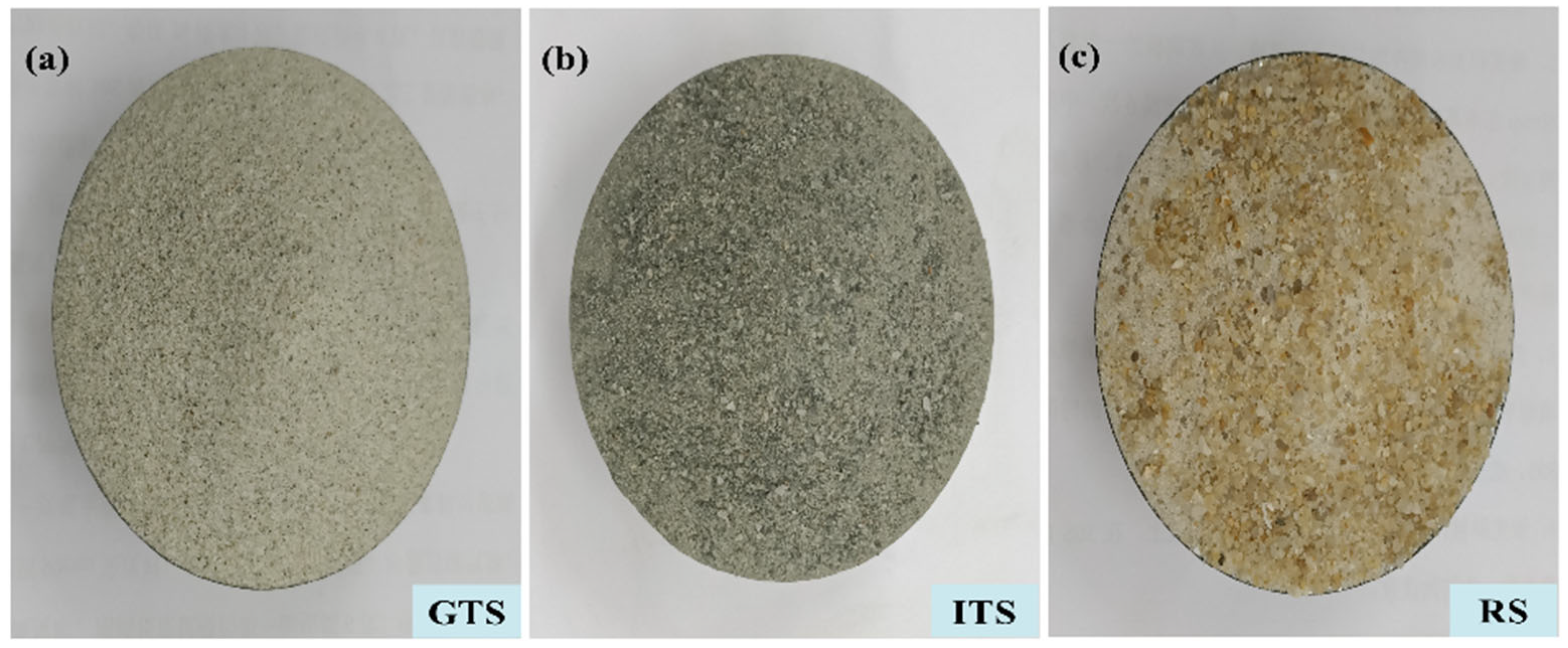
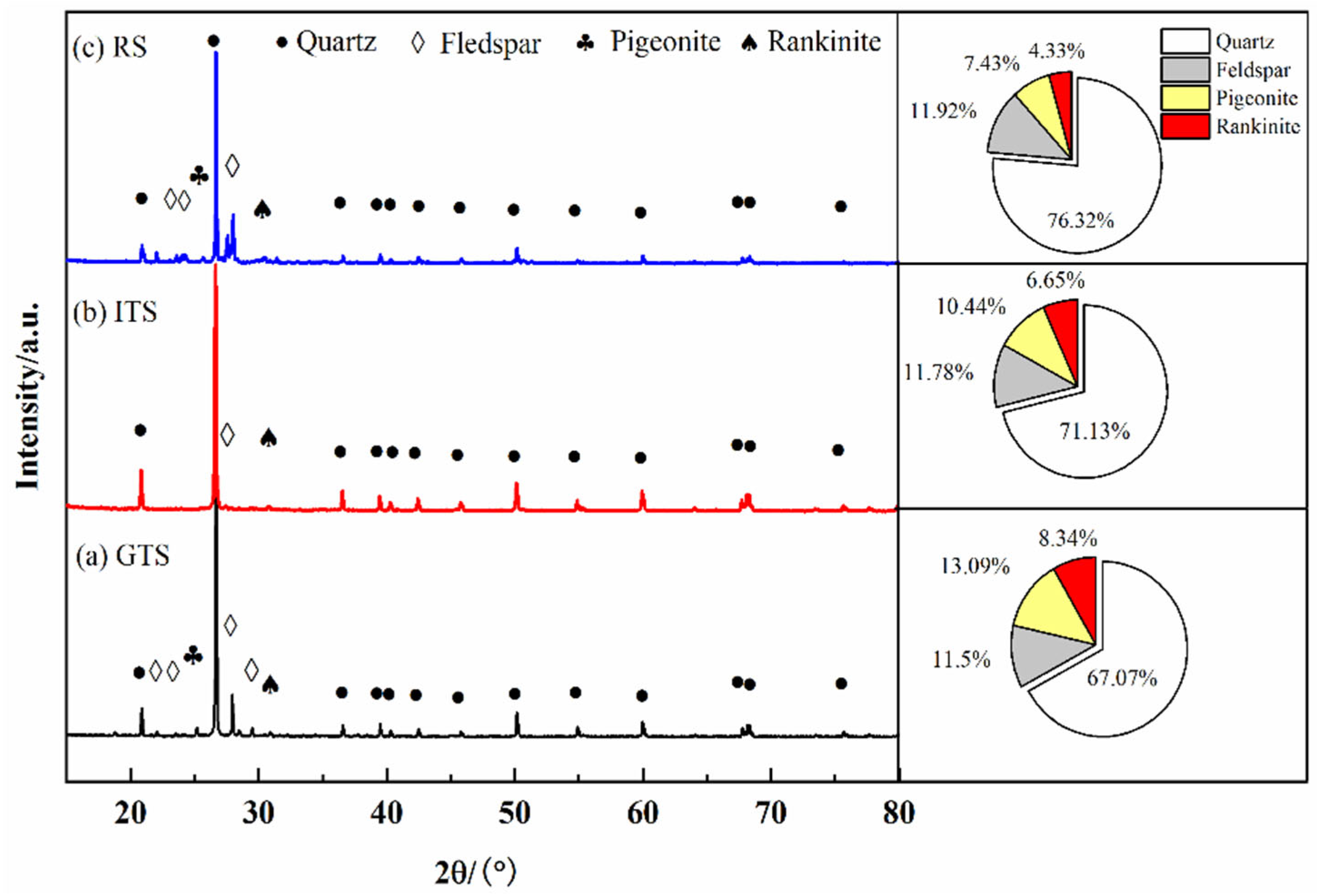

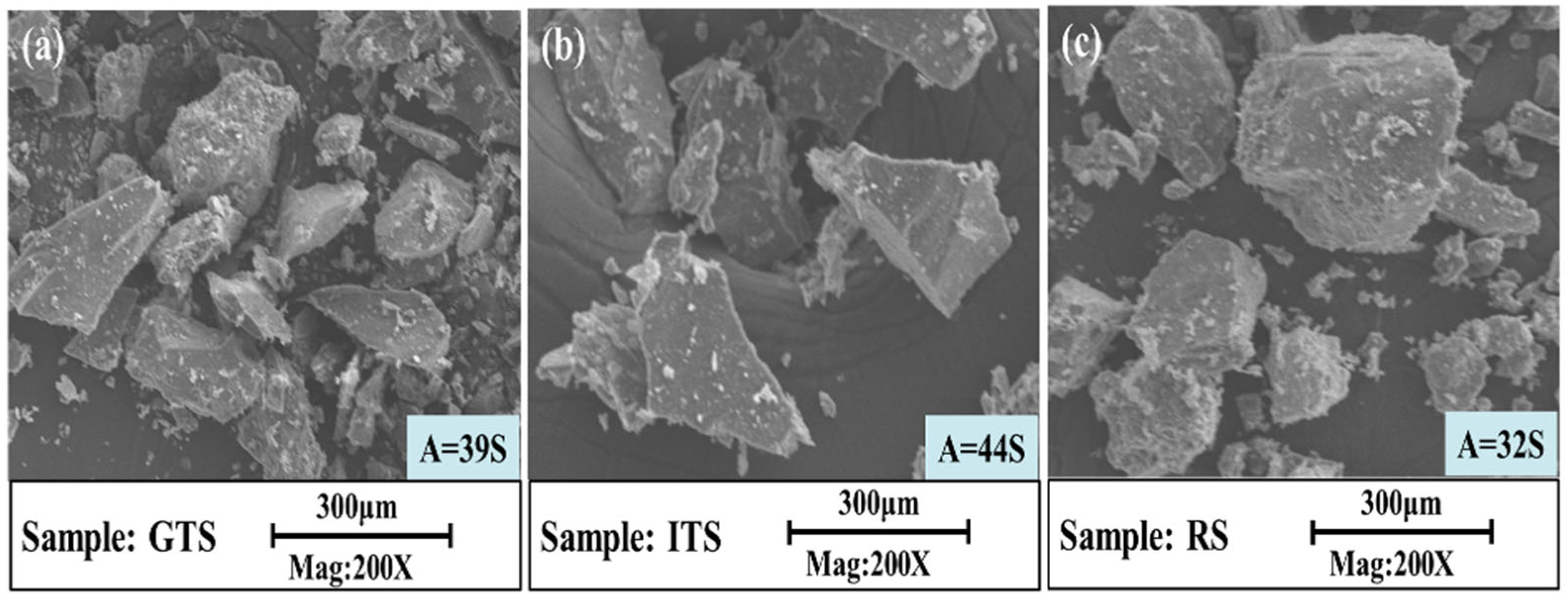
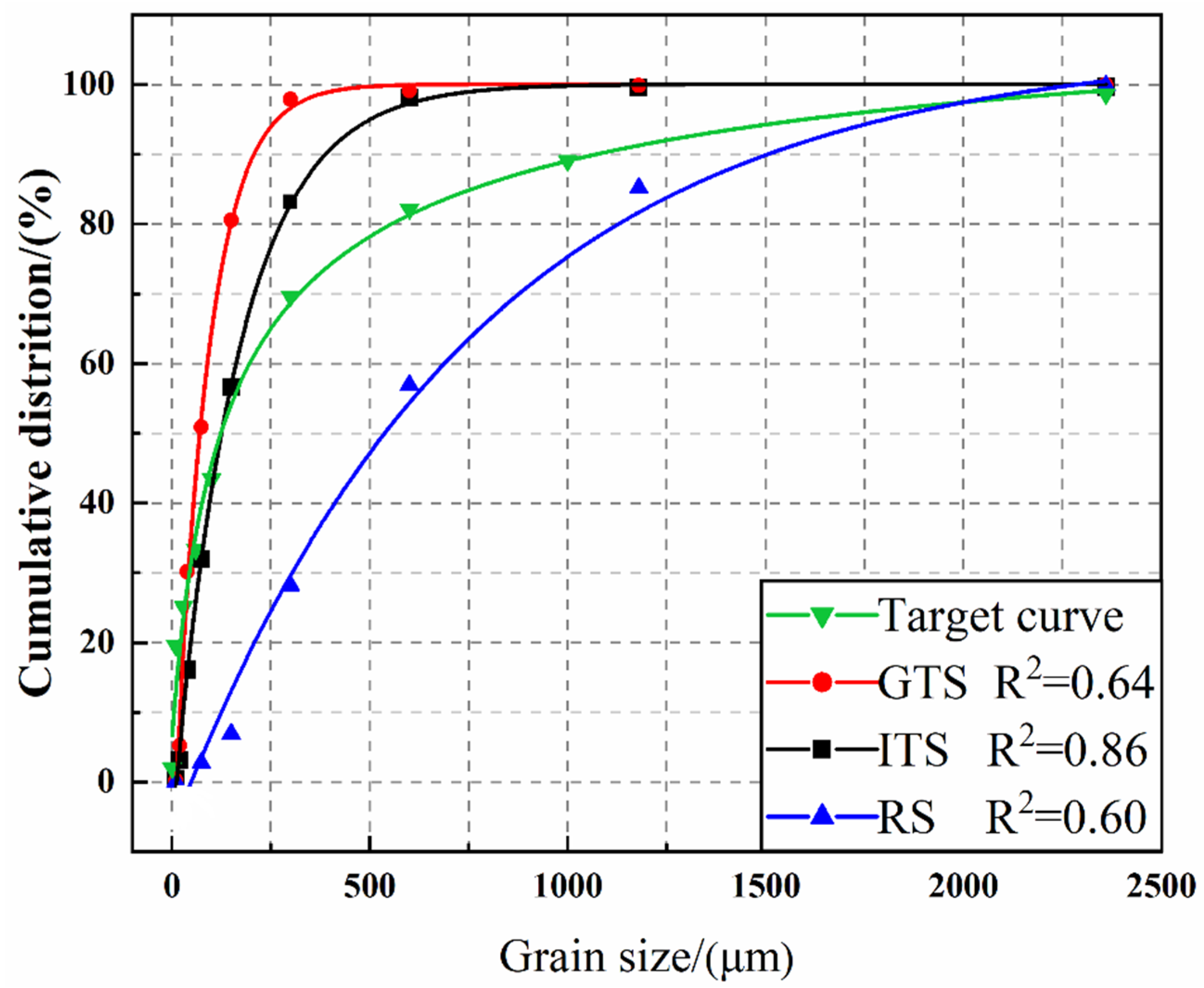
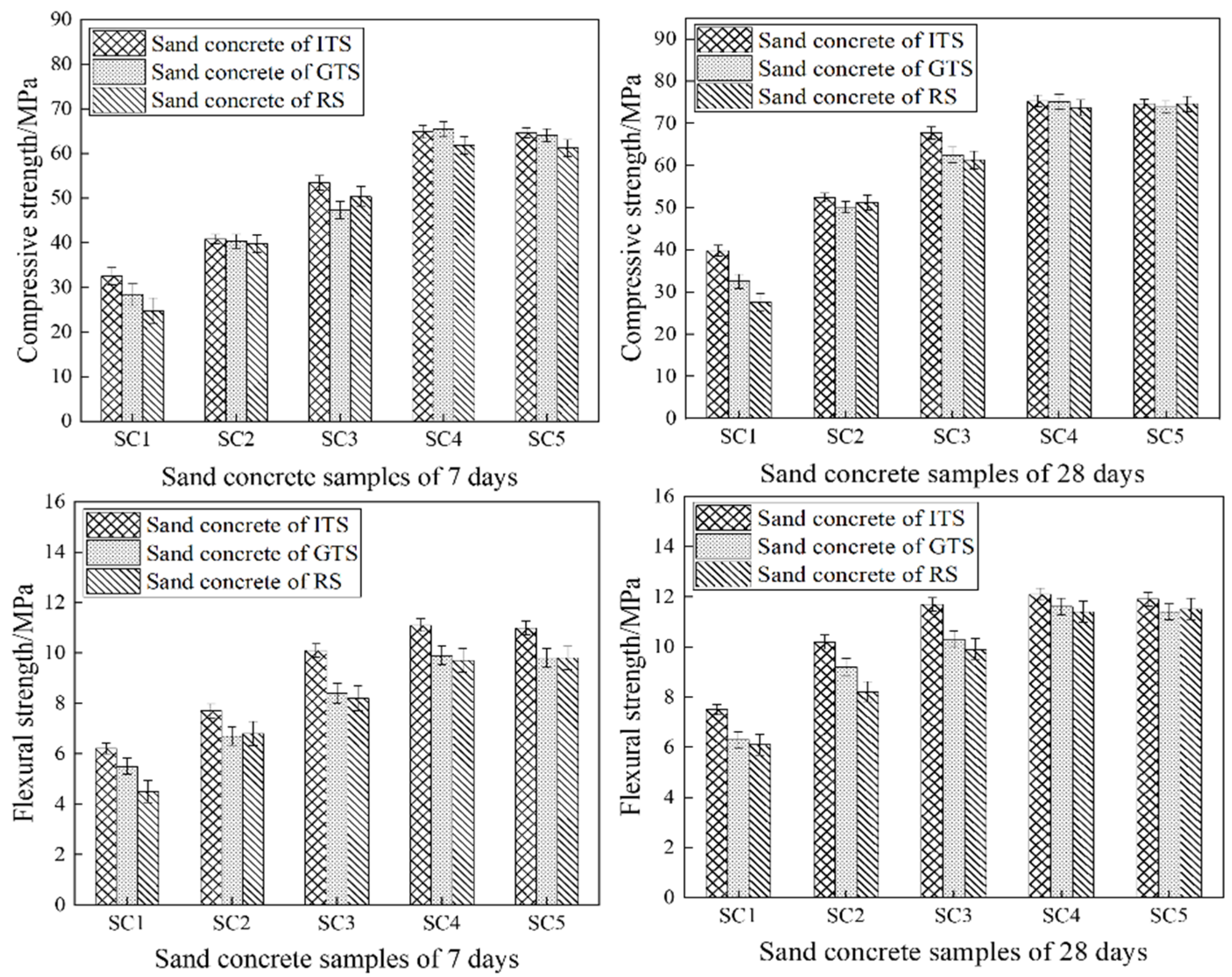

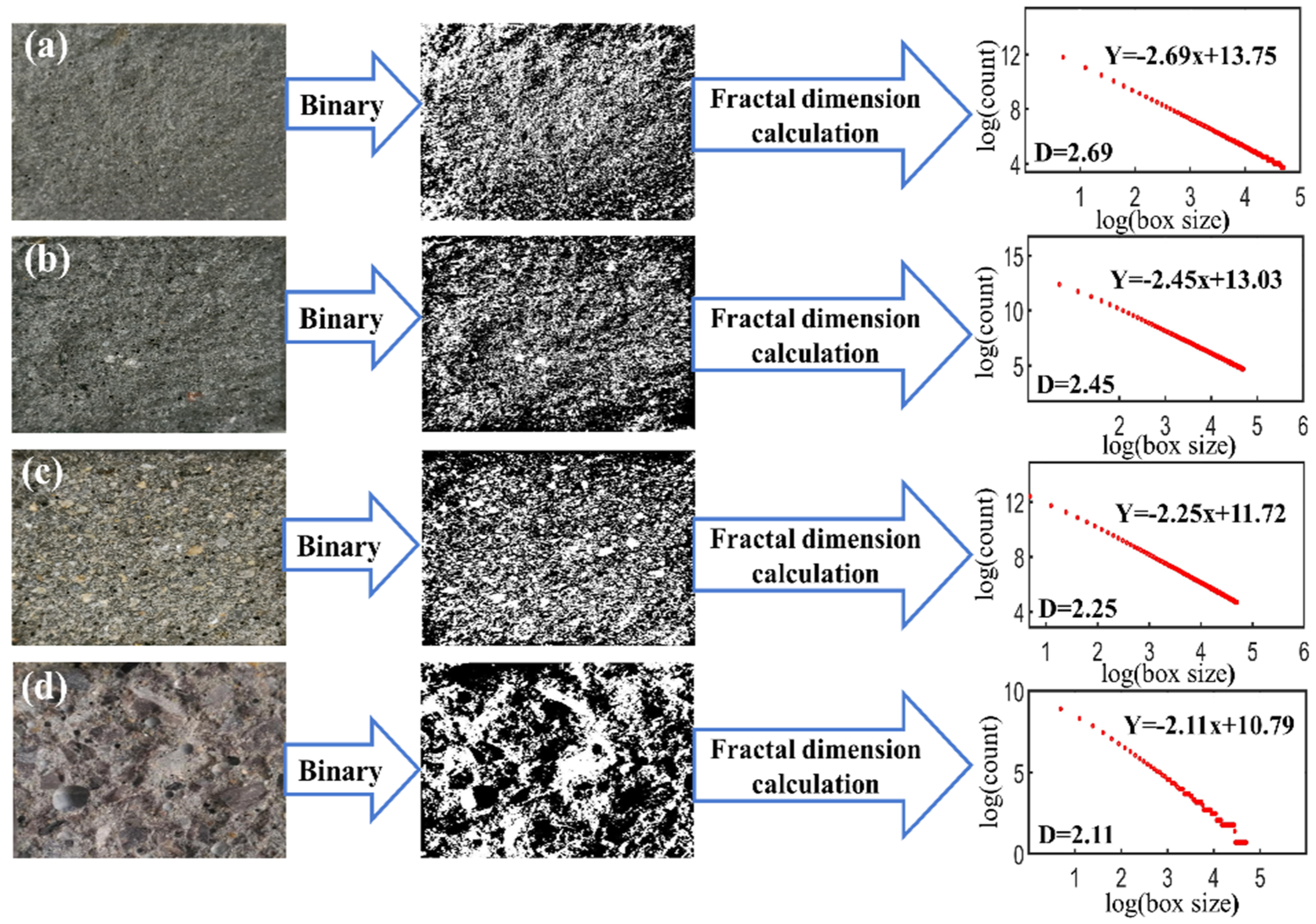
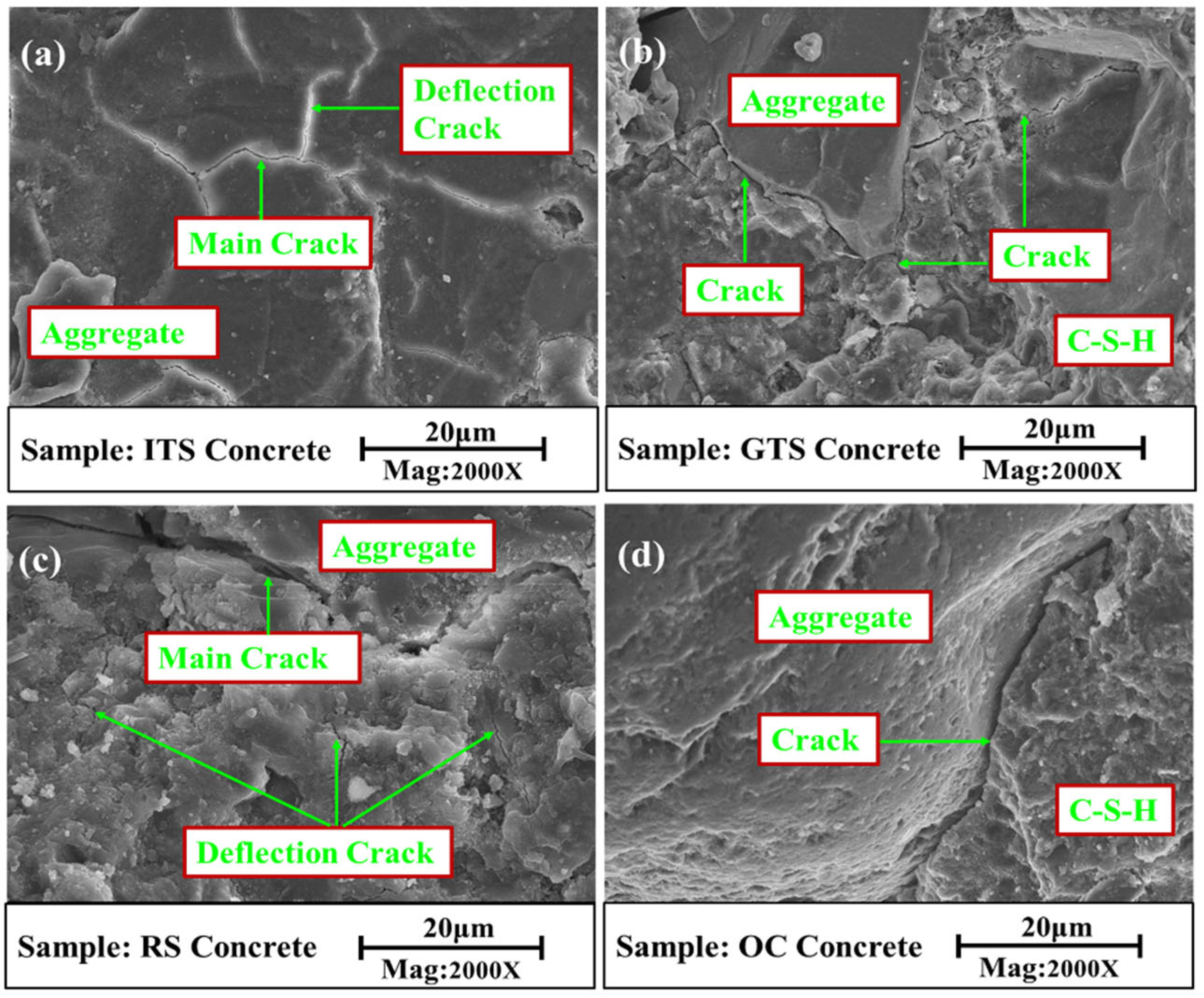
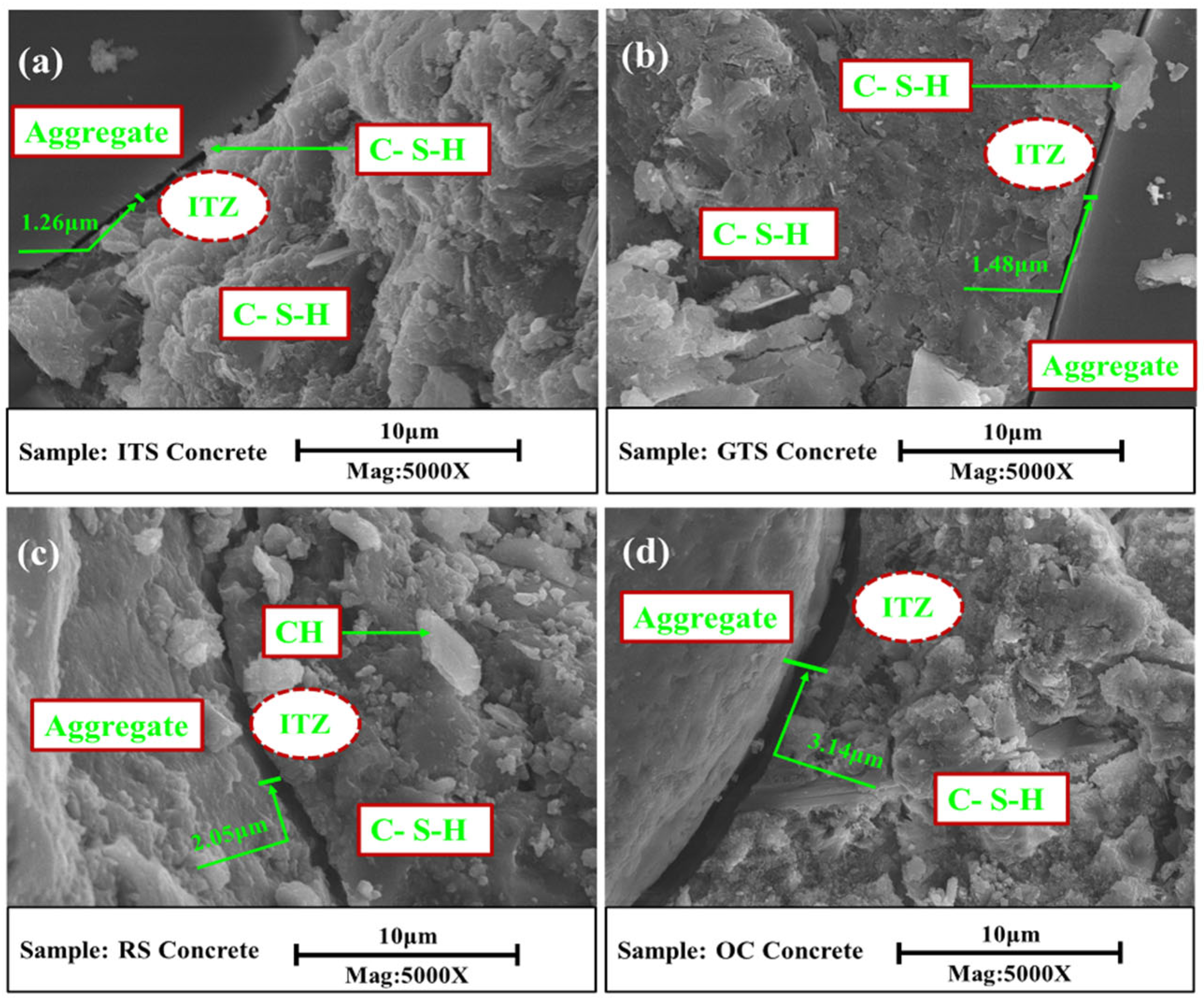
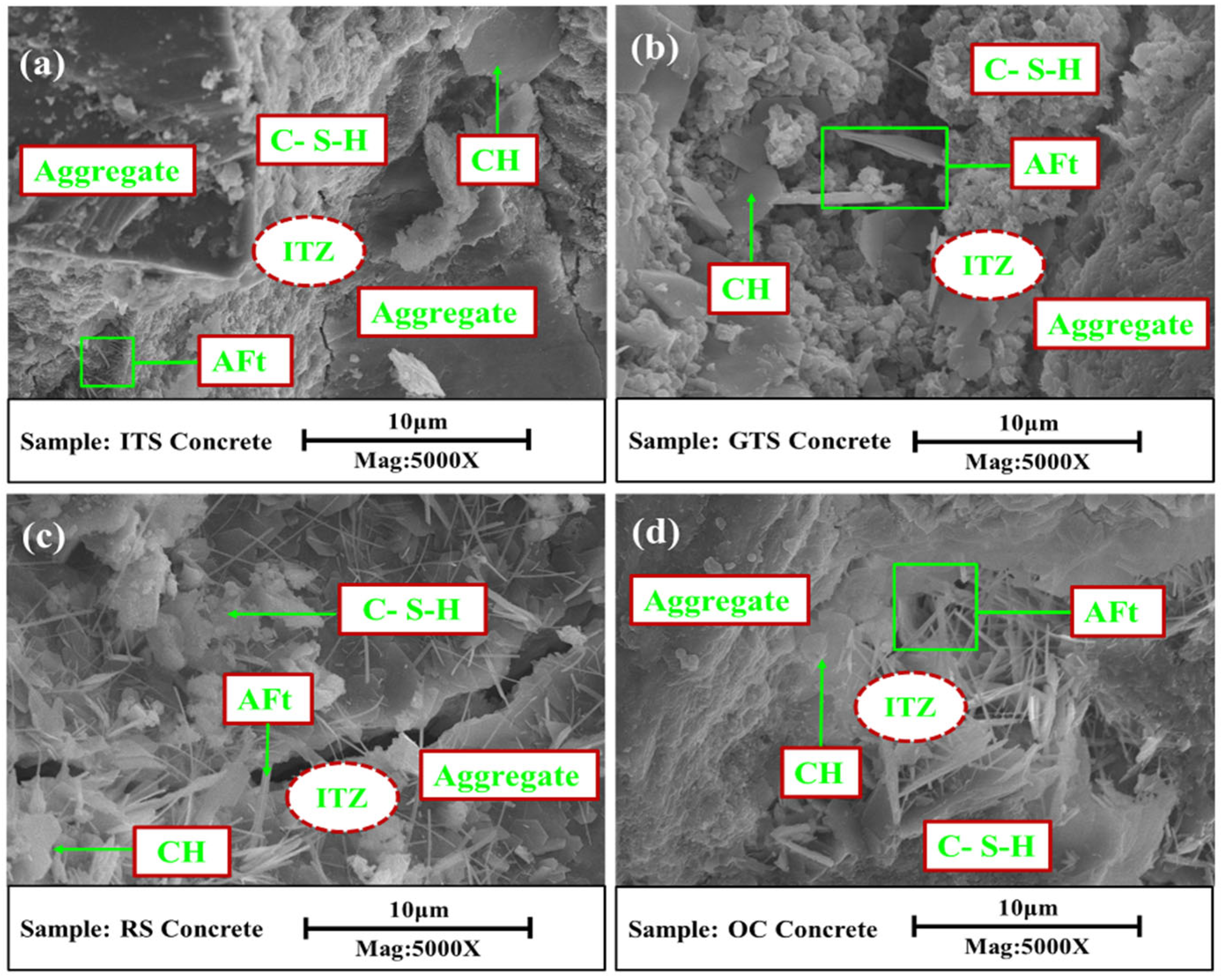
| Specimens | Ratio of Cement to Sand | Cement /kg·m−3 | GTS /kg·m−3 | ITS /kg·m−3 | RS /kg·m−3 | Water /kg·m−3 |
|---|---|---|---|---|---|---|
| SC1 | 585.9 | — | 1757.1 | — | 310.5 | |
| 1:3 | 585.9 | 1757.1 | — | — | 310.5 | |
| 585.9 | — | — | 1757.1 | 310.5 | ||
| SC2 | 669.3 | — | 1673.7 | — | 274.4 | |
| 1:2.5 | 669.3 | 1673.7 | — | — | 274.4 | |
| 669.3 | — | — | 1673.7 | 274.4 | ||
| SC3 | 781.2 | — | 1561.8 | — | 234.4 | |
| 1:2 | 781.2 | 1561.8 | — | — | 234.4 | |
| 781.2 | — | — | 1561.8 | 234.4 | ||
| SC4 | 937.5 | — | 1405.5 | — | 206.3 | |
| 1:1.5 | 937.5 | 1405.5 | — | — | 206.3 | |
| 937.5 | — | — | 1405.5 | 206.3 | ||
| SC5 | 1171.5 | — | 1171.5 | — | 175.7 | |
| 1:1 | 1171.5 | 1171.5 | — | — | 175.7 | |
| 1171.5 | — | — | 1171.5 | 175.7 |
| Type | Chemical Compositions of Raw Materials (wt. %) | |||||||||||
|---|---|---|---|---|---|---|---|---|---|---|---|---|
| SiO2 | Al2O3 | Fe2O3 | CaO | MgO | Na2O | K2O | P2O5 | TiO2 | MnO | LOI | TOTAL | |
| GTS | 73.34 | 7.06 | 3.82 | 3.22 | 1.26 | 1.58 | 2.08 | 0.25 | 0.34 | 0.10 | 3.66 | 96.71 |
| ITS | 75.85 | 7.54 | 6.64 | 4.19 | 2.12 | 0.60 | 0.48 | 0.13 | 0.30 | 0.15 | 0.86 | 98.86 |
| RS | 81.32 | 4.75 | 2.83 | 2.50 | 0.48 | 0.23 | 1.57 | 0.09 | 0.18 | 0.05 | 2.16 | 96.16 |
| Type | Fineness Modulus | Apparent Density (g/cm3) | Bulk Density (g/cm3) | Void Ratio (%) | Average Size (µm) | Specific Area (m2/kg) | Powder Content (<0.075 mm) |
|---|---|---|---|---|---|---|---|
| GTS | 0.62 | 2.67 | 1.40 | 47.62 | 113 | 323 | 32.91% |
| ITS | 1.29 | 2.78 | 1.52 | 45.33 | 225 | 282 | 16.93% |
| RS | 1.92 | 2.64 | 1.48 | 43.57 | 450 | 256 | 6.92% |
Disclaimer/Publisher’s Note: The statements, opinions and data contained in all publications are solely those of the individual author(s) and contributor(s) and not of MDPI and/or the editor(s). MDPI and/or the editor(s) disclaim responsibility for any injury to people or property resulting from any ideas, methods, instructions or products referred to in the content. |
© 2023 by the authors. Licensee MDPI, Basel, Switzerland. This article is an open access article distributed under the terms and conditions of the Creative Commons Attribution (CC BY) license (https://creativecommons.org/licenses/by/4.0/).
Share and Cite
Sun, Z.; Xiong, J.; Cao, S.; Zhu, J.; Jia, X.; Hu, Z.; Liu, K. Effect of Different Fine Aggregate Characteristics on Fracture Toughness and Microstructure of Sand Concrete. Materials 2023, 16, 2080. https://doi.org/10.3390/ma16052080
Sun Z, Xiong J, Cao S, Zhu J, Jia X, Hu Z, Liu K. Effect of Different Fine Aggregate Characteristics on Fracture Toughness and Microstructure of Sand Concrete. Materials. 2023; 16(5):2080. https://doi.org/10.3390/ma16052080
Chicago/Turabian StyleSun, Zhihua, Jin Xiong, Shubo Cao, Jianxiong Zhu, Xuzhi Jia, Zhigang Hu, and Kaiping Liu. 2023. "Effect of Different Fine Aggregate Characteristics on Fracture Toughness and Microstructure of Sand Concrete" Materials 16, no. 5: 2080. https://doi.org/10.3390/ma16052080





